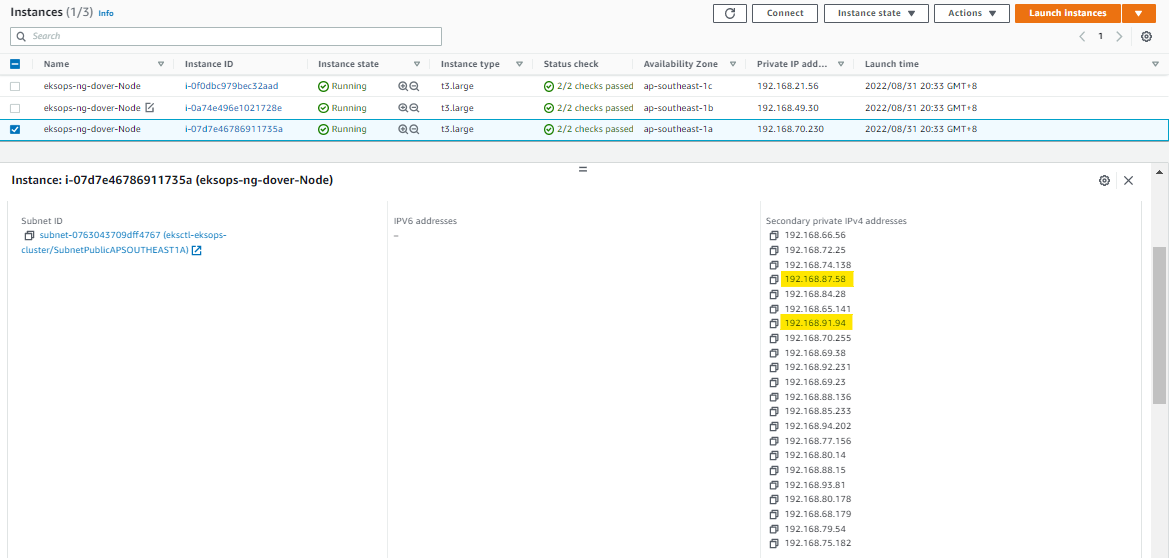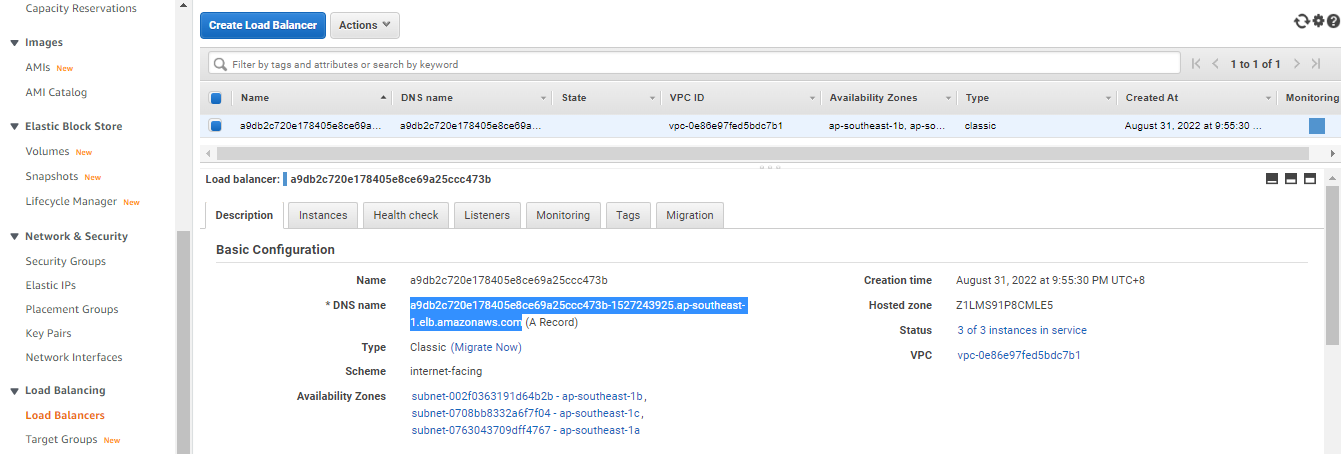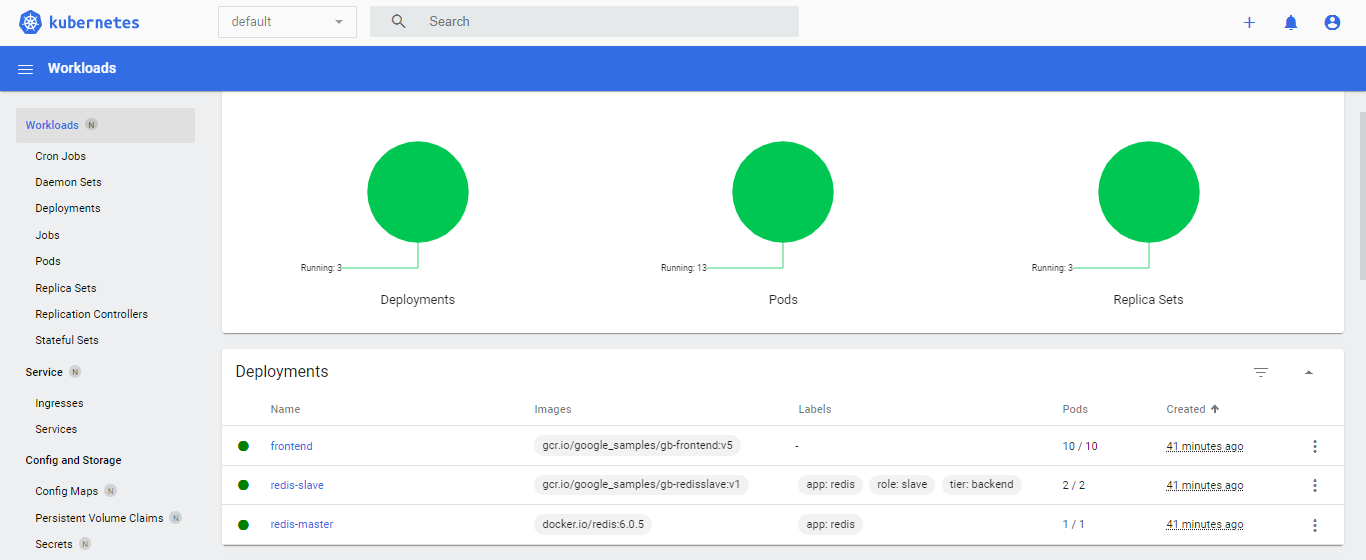All-Things-Docker-and-Kubernetes
Lab 056: Deploy a Stateless Guestbook Application
- Pre-requisites
- Introduction
- The Application Architecture
- Launch a Simple EKS Cluster
- Deploy the Backend Resources
- Deploy the Frontend Resources
- Setup the Kubernetes Dashboard
- Scaling the Pods
- Perform some Chaos Testing
- Cleanup
Pre-requisites
Introduction
In this lab, we’ll deploy an EKS cluster and then deploy a simple guestbook application that uses a Redis database. We’ll also scale up and down our Pods and see the results.
Lastly, we will also get to use and test a publicly accesible AWS LoadBalancer with our Kubernetes cluster.
For this lab, we’ll ap-southeast-1 region (Singapore).
The Application Architecture
.png)
Backend: Redis
- single master (writes)
- multi slaves (reads)
- loadbalancing done internally between slaves
- slaves sync continuously with master
Frontend: PHP App
- uses AWS ELB to loadbalance between the Pods
- “Read” balanced over multiple slave DBs
- “Writes” done on the single machine Redis DB
To learn more about the sample application, check out Guestbook application on Kubernetes.
Launch a Simple EKS Cluster
Before we start, let’s first verify if we’re using the correct IAM user’s access keys. This should be the user we created from the pre-requisites section above.
$ aws sts get-caller-identity
{
"UserId": "AIDxxxxxxxxxxxxxx",
"Account": "1234567890",
"Arn": "arn:aws:iam::1234567890:user/k8s-admin"
}
For the cluster, we can reuse the eksops.yml file from the previous labs.
eksops.yml
```bash apiVersion: eksctl.io/v1alpha5 # apiVersion: client.authentication.k8s.io/v1beta1 kind: ClusterConfig metadata: version: "1.23" name: eksops region: ap-southeast-1 nodeGroups: - name: ng-dover instanceType: t3.large minSize: 1 maxSize: 5 desiredCapacity: 1 ssh: publicKeyName: "k8s-kp" ```Launch the cluster.
$ time eksctl create cluster -f eksops.yml
Check the nodes and pods.
$ kubectl get nodes
Deploy the Backend Resources
Let’s start with creating the backend resources composed of:
- Redis Master Pod
- Redis Master Service (provides accesible fixed URL)
- Redis Slave Pods
- Redis Slave Service (performs the loadbalancing)
Create the redis-master.yml. In this manifest, we’re creating two resources: a deployment and a service.
vim redis-master.yml
redis-master.yml
```bash # SOURCE: https://cloud.google.com/kubernetes-engine/docs/tutorials/guestbook apiVersion: apps/v1 kind: Deployment metadata: name: redis-master labels: app: redis # role: master # tier: backend spec: replicas: 1 selector: matchLabels: app: redis role: master tier: backend template: metadata: labels: app: redis role: master tier: backend spec: containers: - name: master image: "docker.io/redis:6.0.5" resources: requests: cpu: 100m memory: 100Mi ports: - containerPort: 6379 --- apiVersion: v1 kind: Service metadata: name: redis-master labels: app: redis role: master tier: backend spec: ports: - port: 6379 targetPort: 6379 selector: app: redis role: master tier: backend ```In the Deployment, we can see the specifications. The selector tells kubectl to apply the deployment on instances and assign them the three labels: app, role, and tier.
The container image used is the Redis image available from Docker. We’re also specifying limits for the CPU and memory, along with the port to use.
In the Service resource, we also specified the specifications and the labels for the Redis service. This will from the Redis master Pod Deploy the Redis service.
Deploy the resources.
kubectl apply -f redis-master.yml
deployment.apps/redis-master created
service/redis-master created
Check if the Pod is created.
kubectl get pods
NAME READY STATUS RESTARTS AGE
redis-master-7fb7b4d7c5-xvdsb 1/1 Running 0 16m
Also check the service. Notice that the redis-master was assigned a cluster IP, which is only accesible from within the cluster.
kubectl get svc
NAME TYPE CLUSTER-IP EXTERNAL-IP PORT(S) AGE
kubernetes ClusterIP 10.100.0.1 <none> 443/TCP 59m
redis-master ClusterIP 10.100.186.99 <none> 6379/TCP 34m
Let’s now create the redis-slave.yml.
vim redis-slave.yml
redis-slave.yml
```bash # SOURCE: https://cloud.google.com/kubernetes-engine/docs/tutorials/guestbook apiVersion: apps/v1 kind: Deployment metadata: name: redis-slave labels: app: redis role: slave tier: backend spec: replicas: 2 selector: matchLabels: app: redis template: metadata: labels: app: redis role: slave tier: backend spec: containers: - name: slave image: gcr.io/google_samples/gb-redisslave:v1 resources: requests: cpu: 100m memory: 100Mi ports: - containerPort: 6379 # defines how the followers can talk to the Redis master env: - name: GET_HOSTS_FROM value: dns --- apiVersion: v1 kind: Service metadata: name: redis-slave labels: app: redis role: slave tier: backend spec: ports: # the port that this service should serve on - port: 6379 selector: app: redis role: slave tier: backend ```Deploy the slave resources.
kubectl apply -f redis-slave.yml
deployment.apps/redis-slave created
service/redis-slave created
Check if the Pods and services are created. As we can see, all the Pods have beeb assigned a private IP address.
kubectl get pods
kubectl get svc
We can also get more information about the Pods by adding the the “- wide” parameter. Notice the IP addres in the Node column. These are IP address of the instances in which the Pod is currently deployed on.
kubectl get pods -o wide
NAME READY STATUS RESTARTS AGE IP NODE NOMINATED NODE READINESS GATES
redis-master-7fb7b4d7c5-xvdsb 1/1 Running 0 33m 192.168.87.58 ip-192-168-70-230.ap-southeast-1.compute.internal <none> <none>
redis-slave-566774f44b-2nb58 1/1 Running 0 24s 192.168.7.123 ip-192-168-21-56.ap-southeast-1.compute.internal <none> <none>
redis-slave-566774f44b-hhpqn 1/1 Running 0 24s 192.168.91.94 ip-192-168-70-230.ap-southeast-1.compute.internal <none> <none>
Notice that the Redis Master and redis-slave-566774f44b-hhpqn are both running in the same node, based on Node IP. We can also confirm this on the EC2 dashboard.

We can see that an instance has multiple secondary IP addresses attached to the Elastic Network Interfaces (ENI), which in turn is attached to the EC2 instance.
Note that depending on the instance-type that you choose, there is a limitation in the ENI that can be attached to the instance, which means the smaller the instance type, the fewer the ENIs that can be attached, the fewer the IP addresses that can be used, and the fewer the Pods that can be ran in the node.
To learn more about a node,
kubectl describe node <node-ip>
Deploy the Frontend Resources
Now that our backend is ready, wee can now deploy the frontend resources:
- Guestbook Pods
- Guestbook Service (internet-facing AWS LoadBalancer)
After this, we’ll inspect the underlying resources:
- Elastic LoadBalancer
- Security Groups
- Elastic Network Interfaces (ENI)
Let’s create the frontend-app.yml.
vim frontend-app.yml
frontend-app.yml
```bash # SOURCE: https://cloud.google.com/kubernetes-engine/docs/tutorials/guestbook apiVersion: apps/v1 kind: Deployment metadata: name: frontend spec: replicas: 3 selector: matchLabels: app: guestbook tier: frontend template: metadata: labels: app: guestbook tier: frontend spec: containers: - name: php-redis image: gcr.io/google_samples/gb-frontend:v5 env: - name: GET_HOSTS_FROM value: "dns" resources: requests: cpu: 100m memory: 100Mi ports: - containerPort: 80 --- apiVersion: v1 kind: Service metadata: name: frontend labels: app: guestbook tier: frontend spec: # if your cluster supports it, uncomment the following to automatically create # an external load-balanced IP for the frontend service. # type: LoadBalancer type: LoadBalancer ports: # the port that this service should serve on - port: 80 selector: app: guestbook tier: frontend ```Deploy the frontend app.
kubectl apply -f frontend-app.yml
Check the Pods.
kubectl get pods
NAME READY STATUS RESTARTS AGE
frontend-57df59b89c-7css6 1/1 Running 0 53s
frontend-57df59b89c-chcfx 1/1 Running 0 53s
frontend-57df59b89c-t9xcr 1/1 Running 0 53s
redis-master-7fb7b4d7c5-xvdsb 1/1 Running 0 67m
redis-slave-566774f44b-2nb58 1/1 Running 0 34m
redis-slave-566774f44b-hhpqn 1/1 Running 0 34m
Then check the running services. Notice that the frontend service (with type LoadBalancer) has an external-IP. This allows the LoadBalancer to be accesible from the web.
kubectl get svc
NAME TYPE CLUSTER-IP EXTERNAL-IP PORT(S) AGE
frontend LoadBalancer 10.100.151.42 a9db2c720e178405e8ce69a25ccc473b-1527243925.ap-southeast-1.elb.amazonaws.com 80:30694/TCP 79s
kubernetes ClusterIP 10.100.0.1 <none> 443/TCP 93m
redis-master ClusterIP 10.100.186.99 <none> 6379/TCP 68m
redis-slave ClusterIP 10.100.115.57 <none> 6379/TCP 34m
To see full DNS name of the LoadBalancer, run the command below and search for the LoadBalancer Ingress.
kubectl describe service frontend
We can also see this LoadBalancer created in EC2 > LoadBalancers. In the Description, copy the DNS Name.

Open a new browser tab and paste the DNS name. You should now see the guestbook app. Type a message and click Submit.

Setup the Kubernetes Dashboard
The previous lab explained the concept and uses of Kubernetes Dashboard so we’ll not be diving into that here. I do recommend that you check it out since the Kubernetes dashboard is one helpful utility tool which you can use when managing your Kubernetes clusters.
Here’s a summary of commands that we need to run:
Download the metrics server.
kubectl apply -f https://github.com/kubernetes-sigs/metrics-server/releases/download/v0.6.1/components.yaml
Deploy the Kubernetes dashboard.
export KB_VER=v2.5.1
kubectl apply -f https://raw.githubusercontent.com/kubernetes/dashboard/$KB_VER/aio/deploy/recommended.yaml
Create the service account that we’ll use to authenticate to the Kubernetes dashboard.
vim kb-admin-svc.yml
kb-admin-svc.yml
```bash apiVersion: v1 kind: ServiceAccount metadata: name: kb-admin-svc namespace: kube-system --- apiVersion: rbac.authorization.k8s.io/v1 kind: ClusterRoleBinding metadata: name: kb-admin-svc namespace: kube-system roleRef: apiGroup: rbac.authorization.k8s.io kind: ClusterRole name: cluster-admin subjects: - kind: ServiceAccount name: kb-admin-svc namespace: kube-system ```Apply the YAML file.
kubectl apply -f kb-admin-svc.yml
Get the bearer token of the service account that we just created.
kubectl -n kube-system describe secret \
$(kubectl -n kube-system get secret | grep kb-admin-svc | awk '{print $1}')
Run this command to access Dashboard from your local workstation.
kubectl proxy
Open a web browser and paste this URL. Enter the token that we just copied.
http://localhost:8001/api/v1/namespaces/kubernetes-dashboard/services/https:kubernetes-dashboard:/proxy/#/login
Scaling the Pods
To check the Replicasets that we have for each resources, run the command below.
$ kubectl get rs
NAME DESIRED CURRENT READY AGE
frontend-57df59b89c 3 3 3 17m
redis-master-7fb7b4d7c5 1 1 1 17m
redis-slave-566774f44b 2 2 2 17m
We can also check for a specific deployment. As we can see, the frontend resource has 3 Pods currently running.
$ kubectl get deployment frontend
NAME READY UP-TO-DATE AVAILABLE AGE
frontend 3/3 3 3 20m
Let’s scale the replicas for the frontend Pods from 3 to 5.
kubectl scale --replicas 5 deployment frontend
If we try to check again,
$ kubectl get deployment frontend
NAME READY UP-TO-DATE AVAILABLE AGE
frontend 5/5 5 5 21m
Check the Pods. We should now see 5 Pods for the frontend resource.
$ kubectl get pods
NAME READY STATUS RESTARTS AGE
frontend-57df59b89c-brnp5 1/1 Running 0 42s
frontend-57df59b89c-cc274 1/1 Running 0 42s
frontend-57df59b89c-pfzhd 1/1 Running 0 22m
frontend-57df59b89c-srndd 1/1 Running 0 22m
frontend-57df59b89c-tpt2n 1/1 Running 0 22m
redis-master-7fb7b4d7c5-rf8ht 1/1 Running 0 22m
redis-slave-566774f44b-2vmfp 1/1 Running 0 22m
redis-slave-566774f44b-7wq8t 1/1 Running 0 22m
Let’s try to scale the frontend Pods to 2.
kubectl scale --replicas 2 deployment frontend
The replicas can be scaled in the CLI but it can also be done by editing the YAML file. Modify the frontend-app.yml and set the replicas to 8.
vim frontend-app.yml
replicas: 8
Apply the changes.
kubectl apply -f frontend-app.yml
Going back to the Kubernetes dashboard that’s opened in our web browser, click the Deployments tab. We should see here the three resources that we created and their Pods.

NOTE: We should only edit the Replicas, not the ReplicaSets.
kubectl scale --replicas 2 deployment frontend
If we try to run the command below, it will scale the ReplicaSet but it will not immediately update the number of running Pods. This is because it will have some conflict with what the Controller knows.
kubectl scale --replicas 2 rs deployment frontend
The Controller defines the number of Pods based on the Replicas that are defined, so it will continuously overwrite any changes done on the ReplicaSets.
We can also scale the number of Pods through Kubernetes dashboard. In the Deployment section, click the three vertical dots in the right and click Scale.

Let’s try to scale the redis-slave Pods to 5.


Back at the terminal, we could see that the changes have been applied.
$ kubectl get deployment
NAME READY UP-TO-DATE AVAILABLE AGE
frontend 10/10 10 10 49m
redis-master 1/1 1 1 49m
redis-slave 5/5 5 5 49m
Let’s now scale the frontend Pods and the redis-slave Pods for the next section.
$ kubectl scale --replicas 3 deployment frontend
$ kubectl scale --replicas 3 deployment redis-slave
Perform some Chaos Testing
Chaos Monkey is a term coined by Netflix to test the stability of a system by pseudo-randomly rebooting and terminating instances at any given time, which enforces failures. This helps in determining the weakness in the architecture and craft a working automated remediation strategy that could gracefully handle future failures.
In ths section, we’ll observe the self-healing mechanism of Kubernetes by randomly killing Pods and stopping worker nodes. Let’s check the running nodes and Pods.
$ kubectl get nodes
NAME STATUS ROLES AGE VERSION
ip-192-168-28-17.ap-southeast-1.compute.internal Ready <none> 170m v1.23.9-eks-ba74326
ip-192-168-48-37.ap-southeast-1.compute.internal Ready <none> 170m v1.23.9-eks-ba74326
ip-192-168-68-36.ap-southeast-1.compute.internal Ready <none> 170m v1.23.9-eks-ba74326
$ kubectl get pods
NAME READY STATUS RESTARTS AGE
frontend-57df59b89c-lvw9v 1/1 Running 0 98m
frontend-57df59b89c-pjv4f 1/1 Running 0 98m
frontend-57df59b89c-qtbzf 1/1 Running 0 98m
redis-master-7fb7b4d7c5-rf8ht 1/1 Running 0 129m
redis-slave-566774f44b-2qgf9 1/1 Running 0 82m
redis-slave-566774f44b-2vmfp 1/1 Running 0 129m
redis-slave-566774f44b-jmjql 1/1 Running 0 82m
Let’s simulate a failure by deleting 1 of the frontend Pods.
$ kubectl delete pod frontend-57df59b89c-pjv4f
However, if we check the Pods again, we see that it is immediately replaced by a new Pod.
$ kubectl get pods
NAME READY STATUS RESTARTS AGE
frontend-57df59b89c-9gxvz 1/1 Running 0 39s
frontend-57df59b89c-bwv2k 1/1 Running 0 4s
frontend-57df59b89c-qtbzf 1/1 Running 0 99m
redis-master-7fb7b4d7c5-rf8ht 1/1 Running 0 131m
redis-slave-566774f44b-2qgf9 1/1 Running 0 83m
redis-slave-566774f44b-2vmfp 1/1 Running 0 131m
redis-slave-566774f44b-jmjql 1/1 Running 0 83m
Let’s try to delete all the frontend pods.
kubectl delete pod frontend-57df59b89c-29rnv
kubectl delete pod frontend-57df59b89c-bwv2k
kubectl delete pod frontend-57df59b89c-qtbzf
If we check the Pods again, they are now replaced by new ones. We can also see the all three frontend Pods and redis-slave Pods are equally distributed between the 3 nodes.
$ kubectl get pods
$ kubectl get pods -o wide
NAME READY STATUS RESTARTS AGE IP NODE NOMINATED NODE READINESS GATES
frontend-57df59b89c-h2xmt 1/1 Running 0 40s 192.168.8.147 ip-192-168-28-17.ap-southeast-1.compute.internal <none> <none>
frontend-57df59b89c-j8vj9 1/1 Running 0 50s 192.168.44.81 ip-192-168-48-37.ap-southeast-1.compute.internal <none> <none>
frontend-57df59b89c-m2nbs 1/1 Running 0 47s 192.168.83.184 ip-192-168-68-36.ap-southeast-1.compute.internal <none> <none>
redis-master-7fb7b4d7c5-rf8ht 1/1 Running 0 134m 192.168.27.104 ip-192-168-28-17.ap-southeast-1.compute.internal <none> <none>
redis-slave-566774f44b-2qgf9 1/1 Running 0 87m 192.168.59.39 ip-192-168-48-37.ap-southeast-1.compute.internal <none> <none>
redis-slave-566774f44b-2vmfp 1/1 Running 0 134m 192.168.23.97 ip-192-168-28-17.ap-southeast-1.compute.internal <none> <none>
redis-slave-566774f44b-jmjql 1/1 Running 0 87m 192.168.70.130 ip-192-168-68-36.ap-southeast-1.compute.internal <none> <none>
The redis-master Pod is launched in the node with an IP address of “192.168.28.17” along with 1 frontend Pod and 1 redis-slave Pod. Let’s try to kill this node by stopping the EC2 instance through the EC2 dashboard in the AWS Console.

Back at the terminal, we can now see that the Pods are now redistributed to the two remaining nodes.
$ kubectl get pods -o wide
NAME READY STATUS RESTARTS AGE IP NODE NOMINATED NODE READINESS GATES
frontend-57df59b89c-h2xmt 1/1 Running 0 9m5s 192.168.8.147 ip-192-168-28-17.ap-southeast-1.compute.internal <none> <none>
frontend-57df59b89c-j8vj9 1/1 Running 0 9m15s 192.168.44.81 ip-192-168-48-37.ap-southeast-1.compute.internal <none> <none>
frontend-57df59b89c-m2nbs 1/1 Running 0 9m12s 192.168.83.184 ip-192-168-68-36.ap-southeast-1.compute.internal <none> <none>
redis-master-7fb7b4d7c5-rf8ht 1/1 Running 0 143m 192.168.27.104 ip-192-168-28-17.ap-southeast-1.compute.internal <none> <none>
redis-slave-566774f44b-2qgf9 1/1 Running 0 95m 192.168.59.39 ip-192-168-48-37.ap-southeast-1.compute.internal <none> <none>
redis-slave-566774f44b-2vmfp 1/1 Running 0 143m 192.168.23.97 ip-192-168-28-17.ap-southeast-1.compute.internal <none> <none>
redis-slave-566774f44b-jmjql 1/1 Running 0 95m 192.168.70.130 ip-192-168-68-36.ap-southeast-1.compute.internal <none> <none>
Checking the nodes, we see that the “192.168.28.17” is in a NotReady state. If we run the command a few more time, it will change to Ready.
$ kubectl get nodes
NAME STATUS ROLES AGE VERSION
ip-192-168-28-17.ap-southeast-1.compute.internal Ready <none> 3h12m v1.23.9-eks-ba74326
ip-192-168-48-37.ap-southeast-1.compute.internal NotReady <none> 3h12m v1.23.9-eks-ba74326
ip-192-168-68-36.ap-southeast-1.compute.internal Ready <none> 3h12m v1.23.9-eks-ba74326
It may appear that Kubernetes restarted the node when we stopped it. However, if we check the EC2 console again, we now see four nodes. The instance we stopped is not terminated by Kubernetes and a new one was launched as a replacement. Notice also that the new instance took over the same IP of the killed instance.

Checking the terminal again, we see that the Pods are redistributed to the three worker nodes once again.
$ kubectl get pods -o wide
NAME READY STATUS RESTARTS AGE IP NODE NOMINATED NODE READINESS GATES
frontend-57df59b89c-h2xmt 1/1 Running 0 15m 192.168.8.147 ip-192-168-28-17.ap-southeast-1.compute.internal <none> <none>
frontend-57df59b89c-m2nbs 1/1 Running 0 15m 192.168.83.184 ip-192-168-68-36.ap-southeast-1.compute.internal <none> <none>
frontend-57df59b89c-n7vs9 1/1 Running 0 4m52s 192.168.87.19 ip-192-168-68-36.ap-southeast-1.compute.internal <none> <none>
redis-master-7fb7b4d7c5-rf8ht 1/1 Running 0 149m 192.168.27.104 ip-192-168-28-17.ap-southeast-1.compute.internal <none> <none>
redis-slave-566774f44b-2vmfp 1/1 Running 0 149m 192.168.23.97 ip-192-168-28-17.ap-southeast-1.compute.internal <none> <none>
redis-slave-566774f44b-jmjql 1/1 Running 0 102m 192.168.70.130 ip-192-168-68-36.ap-southeast-1.compute.internal <none> <none>
redis-slave-566774f44b-js8vm 1/1 Running 0 4m52s 192.168.28.73 ip-192-168-28-17.ap-southeast-1.compute.internal <none> <none>
Cleanup
Before we officially close this lab, make sure to destroy all resources to prevent incurring additional costs.
$ time eksctl delete cluster -f
Note that when you delete your cluster, make sure to double-check the AWS Console and check the Cloudformation stacks (which we created by eksctl) are dropped cleanly.